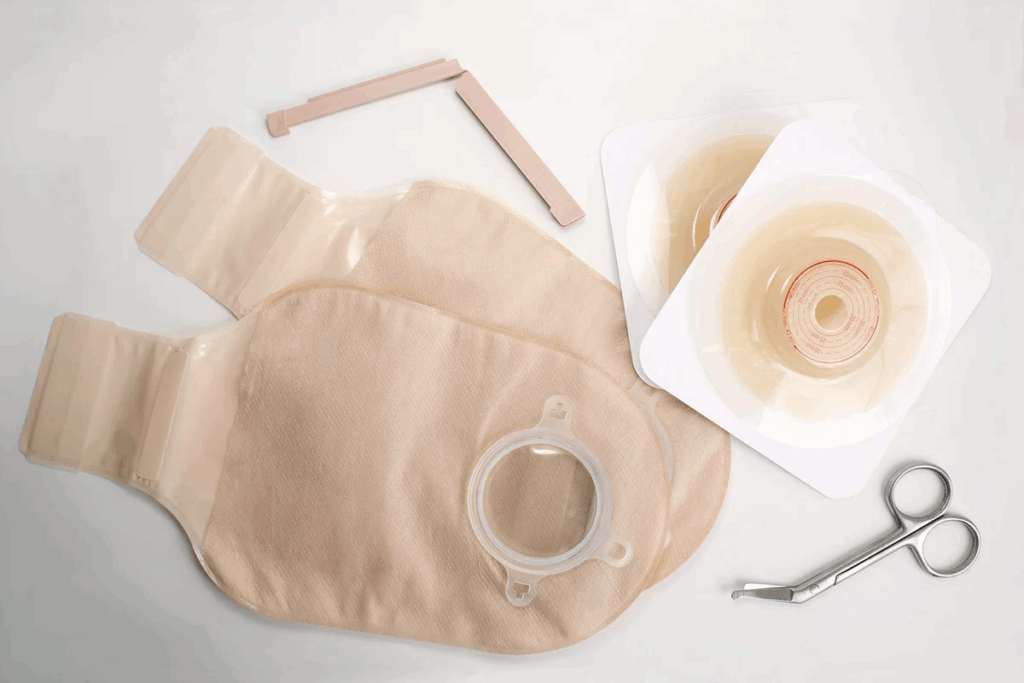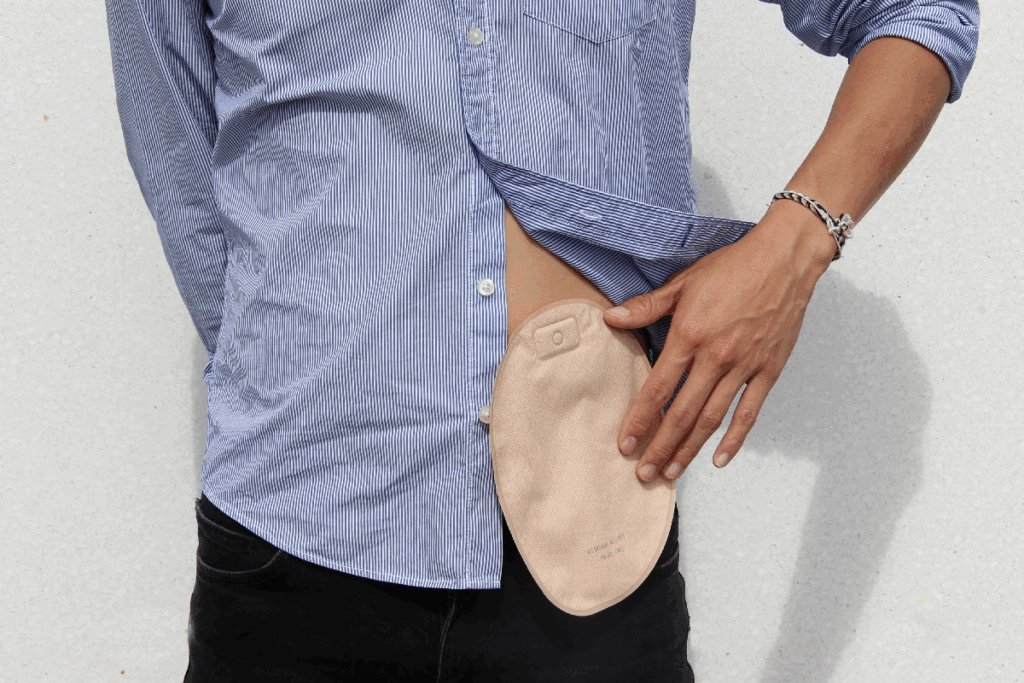Last Updated on October 30, 2025 by Bilal Hasdemir

An ostomy is a surgical procedure that creates a new opening in the body for waste to exit. This new opening, or stoma, can be a result of various medical conditions or injuries. It requires individuals to adapt to a new way of managing their bodily functions. Discover caring for an ostomy essentials, tips, and best practices for comfort and hygiene.
Proper ostomy care is key to avoiding complications like leaks and skin irritation. It helps maintain overall health and confidence. Understanding the different types of ostomies is important. This includes colostomies, ileostomies, and urostomies.
Mastering the techniques for colostomy bag placement and routine cleaning is also vital.

Learning about ostomies starts with knowing what they are and the various types available. An ostomy is a surgical opening in the body for waste diversion.
An ostomy is a medical procedure that creates an opening in the abdomen. It diverts waste or urine flow. This is often needed due to disease, injury, or birth defects in the digestive or urinary systems.
Ostomy surgery aims to improve life quality for those with certain health issues. It removes or bypasses diseased parts of the intestine or urinary tract.
There are three main types of ostomies, each with its own purpose:
Knowing these types is key for effective ostomy care.
| Type of Ostomy | Purpose | Common Indications |
| Colostomy | Diverts fecal matter | Colorectal cancer, diverticulitis |
| Ileostomy | Diverts fecal matter from the colon | Crohn’s disease, ulcerative colitis |
| Urostomy | Diverts urine | Bladder cancer, bladder dysfunction |
Ostomy surgery is often due to cancer, inflammatory bowel disease, or congenital defects. It’s chosen after other treatments have been tried.
Understanding the reasons for ostomy surgery and the types helps in managing care better.

Proper ostomy care starts with the right equipment and supplies. Knowing what you need is key for comfort and confidence every day.
Basic equipment for ostomy care is essential. It includes:
Each ostomy type needs its own products. For example:
It’s important to know what your ostomy needs.
An ostomy care kit helps you stay ready for pouch changes. It should have:
Having the right supplies is key for managing your ostomy. By knowing what you need and carrying a care kit, you can handle your ostomy with confidence.
Getting the ostomy placement right is key to avoiding problems and making patients more comfortable. Where the ostomy is placed can greatly affect a person’s life quality. So, it’s a very important part of taking care of an ostomy.
Marking the spot for the ostomy before surgery is a must. This step helps find the best spot on the belly for the stoma. It considers the patient’s body, lifestyle, and what they prefer. Good pre-operative marking can lower the risk of leaks, skin issues, and trouble with the ostomy.
A healthcare pro, like a stoma nurse or surgeon, does the marking. They look at the belly to find the best spot for the stoma. They think about the belt line, skin folds, and any scars or bumps.
The best spot for a colostomy bag is easy to reach and see. This makes managing the ostomy simpler. The spot should be away from bony parts, scars, and skin folds to avoid irritation and ensure a good fit.
Usually, the colostomy goes in the left lower belly. But, the exact spot can change based on the patient’s needs and the surgery type.
Body shape and how the belly looks are key for a comfortable and working ostomy. The stoma should be placed where there’s little muscle movement or tension. This helps avoid discomfort or problems with the appliance.
Healthcare pros think about the patient’s body shape, belly shape, and any health issues when picking the best spot. This way, they make sure the ostomy is in a spot that’s comfortable and reduces the chance of problems.
Ostomy care is based on key principles for the health of those with an ostomy. These principles help keep the stoma and skin around it healthy.
Checking the stoma every day is important. Look for signs of irritation, unusual output, and pouch function. This helps catch problems early.
Key aspects to monitor daily:
Knowing what a normal stoma looks like is key. A healthy stoma is pink or red, moist, and a bit raised.
Signs of abnormal stoma appearance include:
Having a regular care routine is essential. It should include changing pouches, skin care, and watching for stoma or output changes.
Components of an effective care routine:
Learning how to change an ostomy pouch is key for good care. This process has important steps to keep you comfortable and your skin healthy.
First, get all your supplies ready. You’ll need a new pouch, adhesive remover, skin barrier wipes, and a disposal bag. Changing the pouch in the morning is best, before you eat or drink.
Start by gently peeling off the old pouch from the top down. If it’s stuck, use adhesive remover to avoid discomfort. Then, throw away the used pouch in a disposal bag.
Next, clean the stoma and skin around it with lukewarm water and mild soap. Dry the area with a towel. Check for any irritation or problems.
Measure your stoma to pick the right skin barrier size. If needed, apply a thin layer of paste around the stoma. Then, put the new pouch over the stoma, making sure it’s sealed well.
| Step | Description | Tips |
| 1. Preparation | Gather necessary supplies | Have everything ready before starting |
| 2. Removal | Gently peel off the old pouch | Use adhesive remover if necessary |
| 3. Cleaning | Clean the stoma and surrounding skin | Use lukewarm water and mild soap |
| 4. Application | Apply the new ostomy pouch | Ensure a secure seal around the stoma |
By following these steps, you can take good care of your ostomy and avoid problems.
Cleaning and maintaining your ostomy pouch is key to good care. It keeps you feeling clean, comfortable, and confident. The United Ostomy Associations of America says, “Proper care and maintenance of your ostomy pouch can significantly impact your quality of life.”
Emptying your ostomy pouch is a must. It’s best to empty it when it’s about one-third to one-half full. This helps prevent leaks and keeps odors down. To empty, open the drain at the bottom and pour the contents into a toilet. Then, rinse the drain with water to avoid clogs.
Tips for Effective Emptying:
If you use a reusable ostomy pouch, cleaning it regularly is a must. Rinse the pouch inside and out with lukewarm water. Use mild soap, but make sure to rinse well to remove soap. Let the pouch air dry before using it again.
“Cleaning your ostomy pouch regularly not only maintains hygiene but also extends the life of the pouch.”
Odor management is a big deal for ostomy users. Here are some tips to help:
One patient said, “Using a deodorizer in my pouch has made a big difference in my confidence when I’m out.”
By following these tips, you can keep your ostomy pouch clean and odor-free. This ensures you stay comfortable and confident.
Taking care of the skin around your ostomy is key for your health and comfort. The area around the stoma, called the peristomal skin, is as important as the stoma itself. It helps keep the area clean and prevents problems.
Not taking care of the skin can lead to issues. These include irritation, breakdown, and infections. These can be painful and serious if not treated quickly.
To avoid skin problems, use the right care techniques and products. Here are some steps to take:
| Preventive Measure | Benefit |
| Proper appliance fit | Reduces leakage and friction |
| Skin barrier or protective film | Protects peristomal skin |
| Gentle skin cleaning | Prevents irritation and infection |
If you get skin problems, treat them right away. For irritation, try adjusting the appliance or using a different adhesive. For breakdown, use a protective powder or paste to help heal.
Always talk to a healthcare professional for serious or ongoing skin issues. They can suggest the best treatments and help avoid future problems.
Ostomy care is not a one-size-fits-all solution. It varies a lot between colostomy, ileostomy, and urostomy. Each type needs a special care plan for the best health and comfort.
Colostomy care deals with managing the colon’s output through the stoma. Important steps include:
Tips for Colostomy Care:
Ileostomy care is about handling the liquid from the small intestine. Key points include:
Key Considerations for Ileostomy:
Urostomy care is about managing urine through the stoma. Important steps include:
Urostomy Care Tips:
In conclusion, knowing the specific care guidelines for each ostomy type is key for good management. By following these tailored plans, people with colostomy, ileostomy, or urostomy can stay healthy and enjoy a better life.
Eating well and staying hydrated are key for managing an ostomy. People with an ostomy must watch what they eat to avoid problems and heal quickly.
The type of ostomy affects what you can eat. For example, those with a colostomy might avoid foods that make gas or diarrhea. On the other hand, people with an ileostomy should be careful about foods that could block their stoma.
Colostomy: If you have a colostomy, eat foods low in fiber or avoid ones that cause gas or smell. It’s important to see how different foods affect your stoma.
Ileostomy: Those with an ileostomy should eat a variety of foods for a balanced diet. But, avoid nuts, seeds, and citrus fruits to prevent blockages.
Urostomy: People with a urostomy need to drink plenty of water to avoid urinary tract infections. They should also avoid foods that make urine smell.
Some foods can be trouble for ostomates, including:
Drinking enough water is vital for ostomates to avoid dehydration and stay healthy. Aim for 8-10 glasses of fluid a day, but this can change based on your needs.
Tips for staying hydrated:
Managing ostomy care well is key to living a full life. Activities like bathing, dressing, traveling, and exercising need some changes. But, with the right steps, ostomates can live active and happy lives.
Bathing or showering with an ostomy is easy. It’s best to take off the pouch to clean the stoma and skin well. Use mild soap and lukewarm water to avoid irritation. Dry the skin well before putting the pouch back on.
Choosing the right clothes is important for comfort and confidence. Wear loose-fitting clothes to avoid pressure on the stoma. Look for ostomy belts or underwear for extra support. It’s all about finding clothes that are both stylish and comfortable.
Traveling with an ostomy needs some planning but shouldn’t stop you from exploring. Always pack extra ostomy supplies like pouches and adhesives. Know the medical facilities at your destination and carry a doctor’s letter explaining your condition.
Staying active is vital for health with an ostomy. Most people can do their usual activities, including exercise, after surgery. Try low-impact exercises like walking or yoga for gentle workouts. Always listen to your body and avoid anything that hurts or strains the stoma.
By following these tips, people with an ostomy can live a great life. They can enjoy many activities with confidence and comfort.
It’s important to know about and deal with common ostomy problems. People with an ostomy might face issues like leakage, blockages, and more. These problems need quick action to keep health good.
Leakage is a big problem that can make skin sore. To stop leaks, make sure the ostomy pouch fits right. This means measuring and marking the stoma site carefully before putting on the appliance.
Check the pouch for leaks often and change it when needed. Also, using a skin barrier helps keep the skin around the stoma safe from irritation.
“Proper ostomy care involves not just managing the stoma, but also protecting the surrounding skin.”
Blockages are serious issues with an ostomy. To handle blockages, knowing their causes is key. This includes food blockages in ileostomy patients and dehydration.
It’s important to know when to get medical help for ostomy problems. Look out for severe belly pain, vomiting, or a lot of bleeding.
If you see these signs or other odd symptoms, like constant leakage or blockage, see your doctor right away.
Living with an ostomy means making some changes, but it’s doable. With the right care and support, people can live active and happy lives. Knowing the basics of ostomy care helps build confidence in managing it.
Good ostomy care includes the right tools, a consistent care routine, and knowing about possible problems. Following the advice in this article helps avoid issues and improves life quality.
Being confident with an ostomy means being active in your care, asking for help when you need it, and keeping up with new ostomy care info. With the right attitude and resources, managing an ostomy can be empowering.
By focusing on good care and support, people with ostomies can feel very confident. This confidence lets them enjoy life fully.
Ostomy care is about managing a surgically made opening in the body for waste. It’s key to keep the skin healthy and prevent problems. It helps people with an ostomy stay well.
Changing your pouch depends on your type of ostomy and needs. You might change it every few days or more often. For example, a colostomy pouch might be changed less than an ileostomy pouch.
A good ostomy is pink or red, moist, and not irritated. It should be easy to see and access. The skin around it should also be healthy.
Clean your pouch by emptying it often and rinsing parts with warm water. Use mild soap if needed. Let it dry before putting it back on. This stops bad smells and bacteria.
Problems like leakage, skin irritation, and blockages can happen. To avoid them, make sure the pouch fits right, take care of your skin, and watch for signs. Fixing issues early can stop bigger problems.
Yes, diet matters for each type of ostomy. For instance, ileostomies might avoid high-fiber foods. Colostomies might manage gas foods. Always talk to a healthcare provider or dietitian for advice.
Yes, you can bathe or shower with an ostomy. Remove the pouch first and clean the stoma and skin gently. Put the pouch back on when the area is dry.
Use an odor-filtering pouch, empty it often, and clean it as needed. Some foods can cause smells, so managing what you eat can help too.
If you get a blockage, try to fix it by changing your diet or drinking more water. Use a warm compress if it doesn’t work. If it keeps happening, see a doctor to avoid more issues.
Yes, you can wear most clothes, but loose ones are more comfy. Look into special ostomy clothes or accessories for extra support.
Ostomy care is about managing a surgically made opening in the body for waste. It’s key to keep the skin healthy and prevent problems. It helps people with an ostomy stay well.
Changing your pouch depends on your type of ostomy and needs. You might change it every few days or more often. For example, a colostomy pouch might be changed less than an ileostomy pouch.
A good ostomy is pink or red, moist, and not irritated. It should be easy to see and access. The skin around it should also be healthy.
Clean your pouch by emptying it often and rinsing parts with warm water. Use mild soap if needed. Let it dry before putting it back on. This stops bad smells and bacteria.
Problems like leakage, skin irritation, and blockages can happen. To avoid them, make sure the pouch fits right, take care of your skin, and watch for signs. Fixing issues early can stop bigger problems.
Yes, diet matters for each type of ostomy. For instance, ileostomies might avoid high-fiber foods. Colostomies might manage gas foods. Always talk to a healthcare provider or dietitian for advice.
Yes, you can bathe or shower with an ostomy. Remove the pouch first and clean the stoma and skin gently. Put the pouch back on when the area is dry.
Use an odor-filtering pouch, empty it often, and clean it as needed. Some foods can cause smells, so managing what you eat can help too.
If you get a blockage, try to fix it by changing your diet or drinking more water. Use a warm compress if it doesn’t work. If it keeps happening, see a doctor to avoid more issues.
Yes, you can wear most clothes, but loose ones are more comfy. Look into special ostomy clothes or accessories for extra support.
Subscribe to our e-newsletter to stay informed about the latest innovations in the world of health and exclusive offers!
WhatsApp us